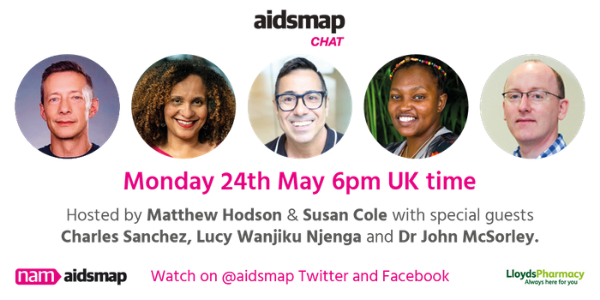News from aidsmap

Two times a year is better than four: people spend less time off ART if they only visit their clinic every six months, African study shows
A cluster-randomised study in Zambia and Malawi has confirmed that patients with stable, non-complicated HIV infection are less likely to have gaps in their supply of antiretroviral therapy (ART) if they only visit their clinic and get their medication every six months instead of every three months or less.
Self-stigma, especially around substance use, impedes HIV self-care among gay and bisexual men living with HIV who use drugs
A qualitative study sought to understand how internalised stigma affects HIV self-care among gay and bisexual men living with HIV who use substances. Men in this cohort experienced self-stigma stemming from multiple intersecting identities, including their HIV status, sexual orientation, race, effeminateness, poverty, and housing instability. Self-stigma around drug use was reported as the most burdensome stigma, as well as the largest barrier to HIV self-care.
HIV is associated with accelerated ageing that antiretroviral therapy only partially reverses
Untreated HIV infection is associated with epigenetic age acceleration, which is more pronounced in individuals with severe immunodeficiency, according to a study recently published in The Lancet HIV. It also suggests that epigenetic ageing can be partly reversed by antiretroviral therapy only two years after starting it. However, no significant difference was found in epigenetic age between the two antiretroviral regimens taken by the study participants.
Black women who live with the consequences of structural racism face poorer outcomes in mental health
There are ethnic inequalities in mental health and socioeconomic status amongst older women living with HIV in the UK, Dr Danielle Solomon reports in Sexually Transmitted Infections. The findings show that women of Black African and Black Caribbean origin are the most likely to experience poverty, psychological distress and social isolation, but are the least likely to receive a diagnosis and support for mental health conditions.

Culturally tailored intervention results in fewer STIs and less condomless sex among Black women in criminal justice system
A randomised clinical trial found that Black justice-involved women who took part in an intervention to prevent STIs and HIV were 54% less likely to be diagnosed with an STI and reported 38% fewer acts of condomless anal and vaginal sex compared to the control group over one year of follow-up.
One in five children on ART still lost to follow-up, while disparities between low- and middle-income countries in sub-Saharan Africa persist
The proportion of children under three months of age starting antiretroviral therapy (ART) doubled from 5% to 10% between 2006 and 2017, while death rates were halved, according to findings from over 32,000 children living with HIV from 16 countries in sub-Saharan Africa. However, one in five children were still lost to follow-up and the study highlighted persisting disparities between low- and middle-income countries in sub-Saharan Africa.
Survival needs overshadow PrEP adherence among women who inject drugs
A qualitative study among women who inject drugs in Philadelphia, Pennsylvania, sought to understand how the daily lives of women who inject drugs impact their ability to adhere to daily PrEP. Women prioritised basic needs over PrEP in the context of personal, social, and structural challenges such as substance use, homelessness, and economic disadvantages. Interactions with institutions also affected their ability to take PrEP.
Tonight: aidsmapCHAT

Tonight at 6pm (UK time), join us on Facebook and Twitter for aidsmapCHAT, our news broadcast for people living with HIV. NAM’s Susan Cole and Matthew Hodson will be talking to actor and writer Charles Sanchez from comedy series Merce, and TheBody.com; HIV activist Lucy Wanjiku Njenga from Positive Young Women Voices; and Dr John McSorley, Chair of the British Association for Sexual Health & HIV (BASHH).
Types of antiretroviral medications

We’ve updated our page on the different types of antiretroviral drugs to include information about the first injectable drugs for HIV treatment as well as fostemsavir, a new drug with a novel mode of action. The page covers the most widely used antiretroviral medications in six drug classes.
Editors' picks from other sources
New report highlights global progress on reducing HIV, viral hepatitis and sexually transmitted infections and signals need for renewed efforts to reach 2030 targets | World Health Organization
Ending the global HIV epidemic will require stronger commitment to address the inequalities, stigma and discrimination that continue to drive the epidemic and prevent many people from accessing the services they need.
Cheaper generic PrEP now available in the United States | POZ
Multiple generic formulations of tenofovir disoproxil fumarate/emtricitabine – the equivalent of Truvada – are now available in the US for HIV treatment and prevention, leading to a dramatic drop in the price of pre-exposure prophylaxis (PrEP).
People with HIV are still dying from a treatable, but neglected, disease: all it needs is a plan | The Conversation
Cryptococcal meningitis is one of the main causes of death of people with HIV. The tests and medicines to diagnose and treat it exist but remain inaccessible to most. A global strategy is needed.
Concern over 'chemsex' grows as COVID-19 shuts Thailand's LGBT+ bars | Thomson Reuters Foundation
Lockdown seen fuelling chemsex parties among gay and bi men, while chemsex users seeking help find scant official support.
aidsmapLIVE

Last week, we held an aidsmapLIVE on health inequalities and HIV. Joining NAM's Susan Cole were: sexual health and HIV doctor at Barts Health NHS Trust, Vanessa Apea; Paulie Calderon-Cifuentes from TransAktion in Denmark; HIV health activist and founder of SisterLove Inc, Dázon Dixon Diallo; and LGBT rights campaigner and founder of SASOD Guyana, Joel Simpson.
